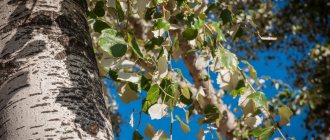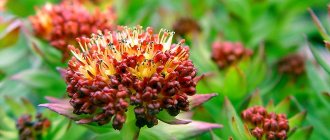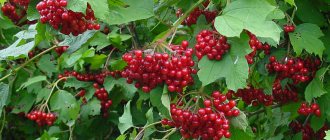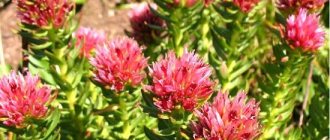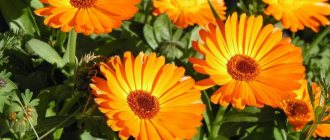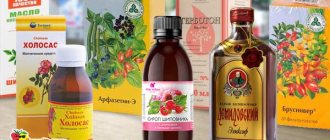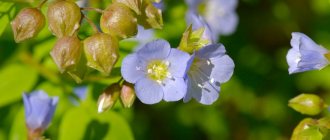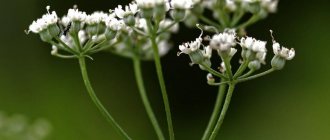Lingonberry is a low perennial shrub with red fruits that grows in forests and taiga, on plains and meadows. Blooms in late May or early July. The medicinal properties of the sour-tasting berry can compete with many medications, and in some cases even surpass them.
general characteristics
Lingonberry is an evergreen shrub with creeping rhizomes. This plant is very small - straight branched stems rarely grow higher than 30 cm. On the outside, the rounded leaves are shiny and dark green, on the inside they are light with brown dots. In spring, flowers with a weak but very pleasant aroma appear on short lingonberry stems. By the end of summer they are replaced by coral berries with reddish-brown seeds. Lingonberry is a perennial plant. Some specimens can bear fruit for almost 300 years. It grows best in forests, swamps, and thickets of arctic and subarctic regions. This plant is “related” to cranberries and blueberries, but is richer in nutritional components. Does well on acidic soils in Greenland, Siberia, the Caucasus, northern Asia, Scandinavia, Canada, and North America.
What are the benefits of lingonberries?
Content:
- general characteristics
- What are the benefits of lingonberries?
- For some it’s berries, for others it’s medicine.
- Benefits for the body
- How our grandmothers treated themselves with lingonberries
- Possible danger
- Culinary ideas
In many countries they know the legend about lingonberries, which in ancient times tried to explain where this small berry, growing in poor northern soil, got so many useful substances from. So, the legend tells about a swallow that carried living water in its beak. The bird dreamed of showering people with this magical liquid and giving them immortality. But bad luck - the swallow was stung by a wasp. In pain, the bird opened its beak and living water spilled out. Life-giving drops fell on three plants - pine, cedar and lingonberry. Since then they have become evergreen and have healing powers.
Some may say: this is just a beautiful fairy tale, with not a grain of truth behind it. But there is truth, and it is that lingonberries really have amazing life-giving powers. And all this is thanks to the rich chemical composition of these forest berries.
Researchers who studied the composition of lingonberries say that with a low calorie content (only 43 kcal per 100 grams), it serves as a rich source of fiber, glucose, vitamins A, and magnesium, calcium, phosphorus, potassium, and omega-3 fatty acids. It contains an impressive amount of flavonoids and lignins, which, according to scientists, are powerful anti-cancer agents. Another substance that protects humans from malignant tumors is quercetin. And lingonberries are second only to blueberries in terms of the content of this useful substance. The berry also contains benzoic acid, which is no less useful and is known for its antimicrobial properties. All of them determine the healing abilities of the berry.
For some it’s berries, for others it’s medicine.
In herbal medicine, lingonberry leaves and fruits are used. Preparations from the greenery of the plant are usually used as diuretics and disinfectants. Due to the rich content of tannins, they have bactericidal and anti-inflammatory properties. The catechins contained in the plant make it useful for strengthening capillaries and preventing microhemorrhages. In many folk recipes, lingonberry leaves are used to treat gastritis, liver diseases, and gout.
Fresh fruits are recommended for people with hypertension and poor eyesight. And folk healers attributed the mixture of berries and honey to those suffering from tuberculosis.
Being a rich source of ascorbic acid and other vitamins, this northern berry is useful for pregnant women, as it improves the condition of the nervous system, muscles (which is important for a healthy birth), strengthens the skeleton of the expectant mother and her child, and also maintains healthy hemoglobin levels.
Residents of the North use this berry to treat diabetes, cardiovascular diseases, fever, kidney dysfunction, some digestive disorders, and edema.
This red berry is considered one of the richest sources of polyphenols and has an anti-sclerotic effect. Like most of its “sisters”, it can increase the level of good cholesterol and stabilize blood pressure.
Benefits for the body
Quercetin and anti-inflammatory effect
In folk medicine, lingonberries are also known as a natural remedy for pain caused by inflammation, including rheumatoid arthritis. Finnish scientists, wanting to scientifically explain this phenomenon, studied the composition of the berries. It turned out that lingonberries contain an extremely high concentration of quercetin, a flavonoid with a strong anti-inflammatory effect.
Medicine for recurrent urinary tract infections
Lingonberry is one of the few foods that contain flavonoid compounds known as proanthocyanidins. These substances, when entering the human body, destroy bacteria that cause urinary tract infections. Including recurrent ones. The effectiveness of the medicine made from lingonberry juice was confirmed by 150 women who took part in a scientific study.
Lingonberry is considered the main natural medicine against cystitis.
The rich content of vitamins B2 and C, manganese, potassium and organic acids helps eliminate inflammatory processes in the bladder.
Cancer cell activity inhibitor
Lingonberries, as studies have shown, can slow down the spread of cancer cells throughout the body. In particular, its effectiveness has been proven for leukemia, cervical and colon cancer. The thing is that this berry is a product with amazing antioxidant properties. Lingonberries, to a greater extent than any other berries, contain flavonoids (antioxidant substances). When they enter the body, they destroy free radicals, preventing many diseases and early aging.
Oral hygiene product.
Inflammation of the gums can often cause not only tooth loss, but also the development of other seemingly unrelated diseases. The easiest way to prevent periodontal disease is to practice good oral hygiene. And lingonberries can play a decisive role in this matter. Possessing anti-inflammatory and antibacterial properties (think quercetin), this berry kills bacteria that cause periodontal disease.
Eliminates age-related pigmentation
Arbutin is an enzyme responsible for skin pigmentation.
In older people, arbutin concentrations decrease. But scientists have found plants that can serve as a source of this enzyme. And lingonberries are also on the list of berries that are useful for maintaining healthy skin pigmentation. To restore skin color, lingonberries can be consumed internally and as a natural cosmetic.
Harm and contraindications
Although lingonberries are safe for most people, they have contraindications and, in some situations, can harm our body. Side effects include:
- Allergic reactions. They are quite rare, but are characterized by a severe course and systemic nature (anaphylactic shock, Quincke's edema).
- Hepatotoxic effect. The berry is capable of accumulating a number of substances that have a toxic effect on the liver. It is recommended to collect berries in ecologically clean areas.
- Dyspeptic disorders. Observed with excessive consumption of lingonberries. Usually manifests itself in the form of vomiting, diarrhea, and bloating.
It is recommended to take a competent approach to including lingonberries in the diet due to the presence of contraindications.
How our grandmothers treated themselves with lingonberries
Lingonberries in folk medicine are usually present in the form of alcohol tinctures, water infusions and decoctions. Leaves, fruits, and roots are used to prepare medicine. By the way, lingonberry root tincture is a well-known remedy against colds and flu. And leaves and stems soaked in alcohol help against headaches, upper respiratory tract diseases and colds. Decoctions and lingonberry teas are often prepared for the treatment of urolithiasis, bleeding, and jaundice. Juice and decoction of berries helps get rid of vitamin deficiency and rheumatism. Such remedies are useful for strengthening the immune system, improving vision, diabetes, and stomach diseases. Below are several ancient recipes from traditional medicine.
For cystitis
Take a glass of boiling water per tablespoon of lingonberry leaves. Wrap up and leave for at least an hour. Take the finished product three times a day before meals, half a glass.
For urolithiasis
Add a glass of boiling water to about 40 g of crushed lingonberry leaves and simmer for 30 minutes in a water bath. Wait for the broth to cool, strain, add boiled water to make 200 ml of broth. Take 60 ml twice a day.
For chronic gastritis
Pour boiling water (1 cup) over a teaspoon of dry herbs and leave for an hour. Drink 50 ml three times a day half an hour before meals.
For constipation
Pour fresh berries with cold boiled water. Leave overnight. Take as a laxative.
For kidney, liver and colic diseases
Pour boiling water over a glass of fresh berries and add 400 ml of cold boiled water. Leave for 6 hours. Take 100 ml before meals 3-4 times a day.
For periodontal disease
In a water bath, prepare a decoction of 10 g of dry lingonberry leaves and a glass of boiling water (simmer for about half an hour). Judge, strain. Rinse the mouth for periodontal disease and stomatitis.
Prevention of pyelonephritis:
1. Dress for the season. Try to keep your lumbar area under a layer of warm clothing. 2. Treat foci of inflammation in the body, because they can also cause pyelonephritis. 3. Visit the clinic twice a year for a preventive examination. 4. Maintain personal hygiene. 5. Try not to get too cold. 6. If you already have pyelonephritis, then visit a urologist, nephrologist and follow all his instructions. 7. If something happens, do not self-medicate. 8. Follow a diet (exclude salty, canned food and baked goods, if there is swelling and high blood pressure, then limit the consumption of water and drinks containing caffeine). 9. If you feel worse, call a doctor immediately!
For questions regarding the treatment of pyelonephritis, you can contact our clinic “MC For the Whole Family”, located at Irkutsk, st. Zheleznodorozhnaya, 2nd, 74. Phone: +7 (3952) 390 - 292.
Culinary ideas
Lingonberries freshly picked from the bush have a tart and sour taste, which not everyone likes. But many people love them in the form of jams, sauces, and syrups. One of the simplest ways to prepare lingonberries is to pour layers of berries and sugar into a jar. In this form, the fruits will retain optimal amounts of nutrients. And this syrup can be stored for quite a long time. If you don’t like whole berries, then try grinding them in a blender and mixing with sugar. This berry puree can also be stored in the refrigerator and added to tea, porridge, pancakes, and pies. And of course, don’t forget that sour wild berries are the best ingredient for making sauces for meat and wild poultry.
Lamb with lingonberry sauce
Ingredients:
- 2 tablespoons chopped thyme;
- 2 tablespoons of chopped parsley;
- 1 teaspoon chopped fresh rosemary;
- large clove of garlic;
- 2 teaspoons mustard;
- 5 tablespoons apple cider vinegar;
- lamb (2 pieces of 8 ribs each);
- half a teaspoon of salt;
- half a teaspoon of black pepper;
- chopped shallots;
- half a glass of lingonberries;
- half a teaspoon of butter;
- a little meat broth.
Mix thyme, parsley, rosemary, mustard and garlic in a saucepan, add a tablespoon of vinegar. Meanwhile, season the lamb with salt and pepper and fry over high heat until crust forms. Transfer the meat to a baking dish and sprinkle with the prepared spice mixture. Bake until done. While the meat is in the oven, mix the rest of the vinegar and shallots, bring to a boil, add broth (about half a glass), boil until the liquid is reduced by half. Add a little salt, black pepper and lingonberries (you can pour boiling water over them first). Stirring everything together, cook for about another minute. Remove from heat, add butter, stir. Serve lamb cut into portions with sauce.
Preparations for the winter
There are several ways to increase the shelf life of lingonberries. Among the main ones are:
- Freezing. Frozen lingonberries retain the maximum amount of vitamins and antioxidant substances, therefore, they are the most useful.
- Drying. In dried lingonberries, the content of fiber and carbohydrates increases several times. They may not be safe for people who are obese or have diabetes.
- Options with excess sugar. Jam, as well as lingonberries pureed with sugar, have an extremely high content of simple carbohydrates. But the availability of valuable substances is reduced by about 40-60%. People who are overweight or have glycemic diseases should avoid such dishes.
There are many ways to increase the shelf life of berries. Freezing is most preferred.
